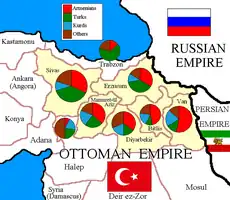Six Vilayets
The Six Vilayets (Ottoman Turkish: ولايت سته, Vilâyat-ı Sitte), the Six Provinces, or the Six Armenian Vilayets (Armenian: Վեց հայկական վիլայեթներ Vets' haykakan vilayet'ner; Turkish: Altı vilayet, Altı il[1]) were the main Armenian-populated vilayets ("provinces") of the Ottoman Empire. These were Van, Erzurum, Mamuret-ul-Aziz, Bitlis, Diyarbekir and Sivas.
| Six Vilayets ولايت سته | |
|---|---|
| Vilayets of Ottoman Empire | |
.png.webp) The six Armenian provinces in early 20th century. | |
| History | |
| Today part of | Turkey |
Name
The term Six Vilayets was a diplomatic usage referring to the Ottoman vilayets with substantial Armenian populations. European diplomats often referred to the Six Armenian Vilayets during the Congress of Berlin in 1878.[2]
Population
Ethnic groups


- Statistical analysis of the racial elements in the Ottoman provinces by the Armenian Patriarch of Constantinople, 1912[3]
Note: The analysis excludes certain portions of these provinces where Armenians are only a minor element. These portions are as follows: Hakkiari, in the Vilayet of Van; the south of Sairt, in the Vilayet of Bitlis; the south of the Vilayet of Diyarbekir; the south of Malatia, in the Vilayet of Mamuret-ul-Aziz; the north-west and west of the Vilayet of Sivas.[3]
| Ethnic groups | Bitlis | Diyarbekir | Erzurum | Mamuret-ul-Aziz | Sivas | Van | TOTAL | % |
| Armenians | 180,000 | 105,000 | 215,000 | 168,000 | 165,000 | 185,000 | 1,018,000 | 38.9 |
| Turks1 | 48,000 | 72,000 | 265,000 | 182,000 | 192,000 | 47,000 | 806,000 | 30.8 |
| Kurds2 | 77,000 | 55,000 | 75,000 | 95,000 | 50,000 | 72,000 | 499,000 | 19.1 |
| Others3 | 30,000 | 64,000 | 48,000 | 5,000 | 100,000 | 43,000 | 290,000 | 11.1 |
| TOTAL | 382,000 | 296,000 | 630,000 | 450,000 | 507,000 | 350,000 | 2,615,000 | 100 |
|
1 including Qizilbash | ||||||||
- Ottoman official population statistics, 1914[4]
Note: The Ottoman population statistics doesn't give information for separate Muslim ethnic groups such as the Turks, Kurds, Circassians, etc.
The official Ottoman population statistics of 1914 that were based on an earlier census underestimated the number of ethnic minorities, including the number of Armenians.[5] The Ottoman figures didn't define any ethnic groups, only religious ones. So the “Armenian” population as counted by the authorities only tallied ethnic Armenians who were also adherents of the Armenian Apostolic Church. Ethnic Armenians who professed the Muslim faith, which by that time had grown in number, were counted only as “Muslims” (not as Armenian Muslims or Armenians), while Armenian Protestants, just as Pontic Greeks, Caucasus Greeks, and Laz, were counted as "others".
| Ethnic groups | Bitlis | Diyarbekir | Erzurum | Mamuret-ul-Aziz | Sivas | Van | TOTAL | % |
| Muslims | 309,999 | 492,101 | 673,297 | 446,376 | 939,735 | 179,380 | 3,040,888 | 79.6 |
| Armenians | 119,132 | 65,850 | 136,618 | 87,862 | 151,674 | 67,792 | 628,928 | 16.5 |
| Others | 44,348 | 4,020 | 5,797 | 4,047 | 78,173 | 11,969 | 148,354 | 3.9 |
| TOTAL | 473,479 | 561,971 | 815,712 | 538,285 | 1,169,582 | 259,141 | 3,818,170 | 100 |
- Maps
 1893-96, Armenian population
1893-96, Armenian population.JPG.webp) Armenian population in the Six Vilayets.
Armenian population in the Six Vilayets.
Largest cities
All figures are as of early 20th century.
| City | Vilayet | Population | Armenians | % |
|---|---|---|---|---|
| Van[6] | Van Vilayet | 40,000 | 25,000 | 62.5% |
| Sivas[7] | Sivas Vilayet | 60,000 | 30,000 | 50% |
| Erzurum[8] | Erzurum Vilayet | 60,000 | 15,000 | 25% |
| Mezereh[9] | Vilayet of Mamuret-ul-Aziz | 12,000 | 6,000 | 50% |
| Bitlis[7] | Bitlis Vilayet | 30,000 | 7,000 | 23% |
| Diyarbakır | Diyarbekir Vilayet | 150,000 | 45,000 | 33% |
| Arapgir[10] | Vilayet of Mamuret-ul-Aziz | 20,000 | 10,000 | 50% |
| Malatya[11] | Vilayet of Mamuret-ul-Aziz | 40,000 | 20,000 | 50% |
See also
References
- Notes
- (in Turkish) İsmail Soysal, Türkiye'nin Siyasal Andlaşmaları, I. Cilt (1920-1945), Türk Tarih Kurumu, 1983, p. 14.
- Verheij, Jelle (2012). Jongerden, Joost; Verheij, Jelle (eds.). Social Relations in Ottoman Diyarbekir, 1870–1915. Brill. p. 88. ISBN 9789004225183.
- "The Treatment of Armenians in the Ottoman Empire 1915-1916" by JAMES VISCOUNT BRYCE, London, T. Fisher Unwin Ltd., 1916
- "1914 Population Statistics" (PDF). Turkish General Staff. pp. 603–628. Archived from the original (PDF) on 7 October 2011. Retrieved 29 January 2011.
- Steven T. Katz,The Holocaust in Historical Context, 1994, p. 86 ...indicates (based on 1919 British estimates) that though Ottoman data were generally reliable they did underestimate the Armenian population in 1914...
- Hakobyan 1987, p. 236.
- Hakobyan 1987, p. 222.
- Hakobyan 1987, p. 163.
- Hakobyan 1987, p. 134.
- Hakobyan 1987, p. 51.
- Hakobyan 1987, p. 182.
- Bibliography
- Hakobyan, Tadevos (1987). Պատմական Հայաստանի քաղաքները (Cities of historic Armenia) (in Armenian). Yerevan: "Hayastan" Publishing.